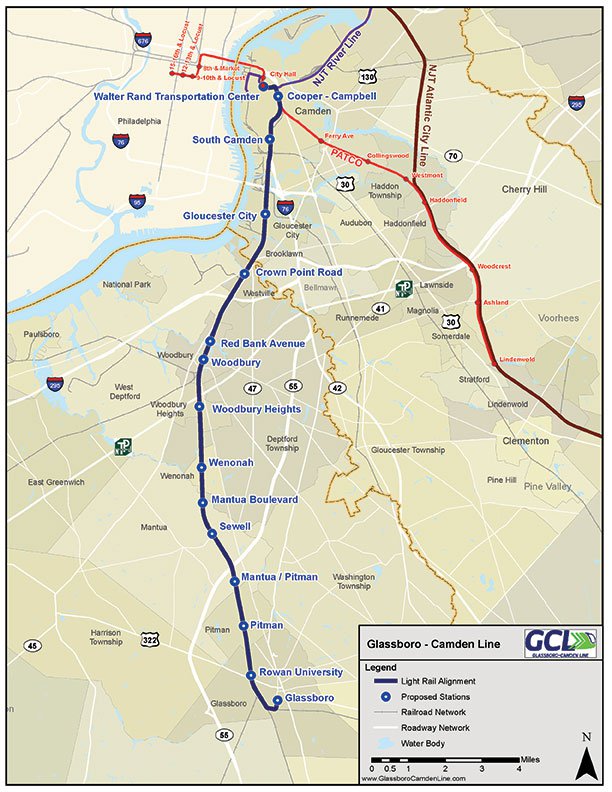
February 25, 2021
 @GlassboroCamden/Twitter
@GlassboroCamden/Twitter
The proposed Glassboro Camden Line, pictured in the rendering above, is an 18-mile light-rail train project that aims to increase transportation access in South Jersey.
A plan for an 18-mile light-rail line through Camden and Gloucester counties has completed an environmental impact study for review by the New Jersey Department of Environmental Protection, moving another step closer to an ambitious project that advocates say would strengthen the region's transportation infrastructure.
Plans for the project date back 2005, when a group of stakeholders proposed it as a solution for the lack of fixed-rail transit in South Jersey. The project is sponsored by the Delaware River Port Authority, PATCO and NJ Transit, with $200 million already pledged by the South Jersey Transportation Authority.
The Glassboro Camden Line calls for 14 new train stations, shown on the map below, and it trains would carry riders along an existing Conrail line using diesel, light-rail vehicles.
The fourteen stops on the proposed 18-mile Glassboro Camden Line would traverse the communities of Glassboro, Pitman, Sewell, Mantua Township, Deptford Township, Wenonah, Woodbury Heights, Woodbury, Westville, Brooklawn, Gloucester City and Camden.
The project's proponents say expanding rail service is necessary in light of an anticipated population boom in Gloucester County over the next few decades, spurred by business development and growing student enrollment at Glassboro's Rowan University and Rutgers University-Camden.
The Delaware Valley Regional Planning Commission’s Connections 2045 Plan for Greater Philadelphia previously estimated that Gloucester County’s population and employment would grow by 29% between 2015 and 2045.
Supporters also point to ongoing redevelopment in Camden, where the Walter Rand Transportation Center already is poised to undergo a $250 million overhaul. They say transit-oriented development in South Jersey will raise property values, reduce traffic congestion and provide greater accessibility across the region.
"The GCL project is a vital transportation link for South Jersey, one that is long overdue," said Jeffrey L. Nash, Camden County Commissioner and DRPA vice chairman. “The GCL will serve to reduce our carbon footprint, increase property values for homeowners, spark economic opportunities for businesses, and provide a convenient means of transportation for workers, students, and those who want easy access to the universities, hospitals, and cities.”
The Final Environmental Impact Statement comes after a draft in November was reviewed during a series of virtual public meetings. Projects of this magnitude typically meet some community resistance, as noted this week by Railway Age, with concerns often centering on crime entering the suburbs and disruptions caused by construction activity.
This environmental study will now be reviewed by NJDEP, which will provide a written response, identifying potential adverse environmental impacts from the project, as well as any permits and regulatory requirements necessary to move forward through its various stages.
The next step in the process would be preliminary engineering design and project management.
The estimated cost of the project, quoted in a 2009 mass transit alternatives analysis study, was pegged at $1.6 billion at the time. Updated information about the anticipated cost as of 2021 has been requested from the project team.
With expanding opportunities for education, employment and home ownership in South Jersey, the team behind the Glassboro Camden Line believes it could be a game changer for the region's transportation network.
"The GCL will effectively extend the Philadelphia-Camden metropolitan area," said John T. Hanson, DRPA CEO and PATCO President. "This commuter rail line will provide convenient transportation for workers, students, and those who want easy access to the many cultural, recreational, educational, economic and medical resources on both sides of the river."
 Source/GlassboroCamdenLine.com
Source/GlassboroCamdenLine.com